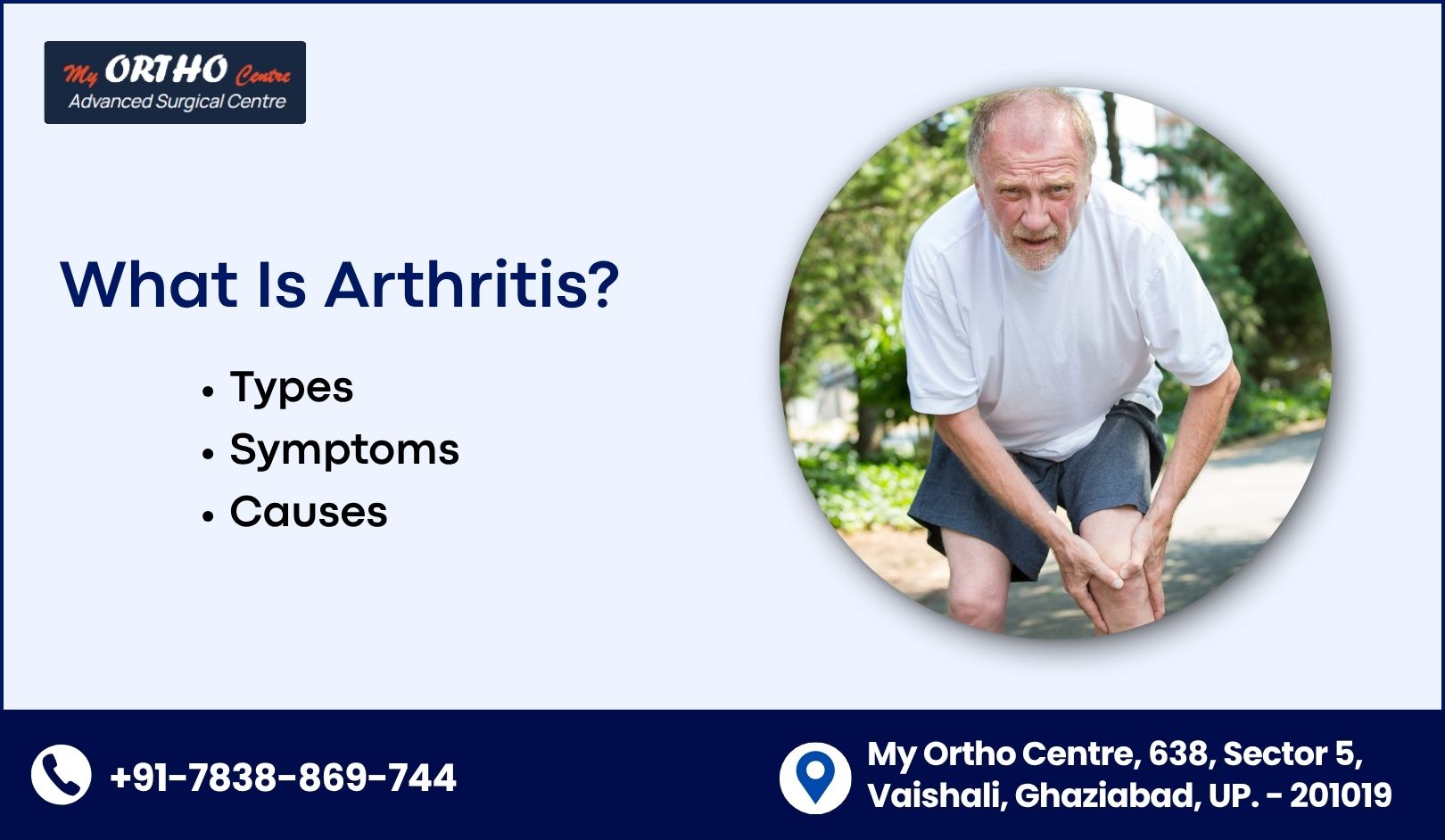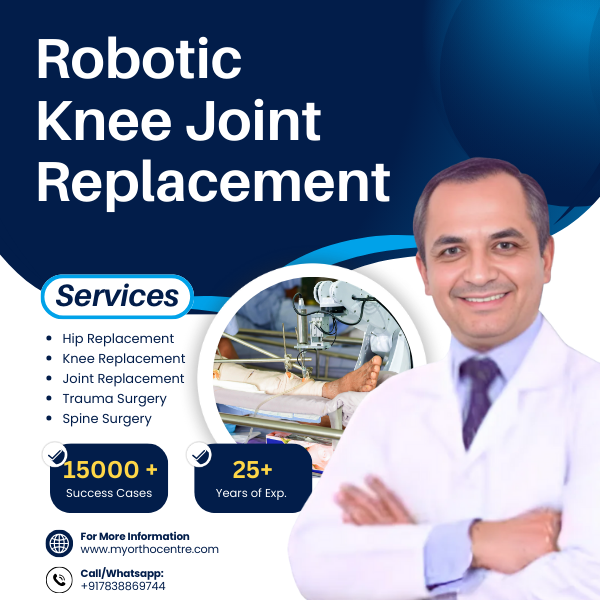Every step, every movement, every small twist of the body depends on the smooth functioning of our joints. But when stiffness, pain, and swelling begin to interfere with daily life, arthritis may be the underlying reason.
Millions of people worldwide suffer from this condition — from young adults with autoimmune arthritis to elderly individuals with degenerative joint damage. The World Health Organization (WHO) estimates that 1 in 4 adults experiences arthritis symptoms during their lifetime.
At My Ortho Centre, under the expert care of Dr. Mohit Madan, one of the best orthopaedic in Vasundhara, Ghaziabad, patients receive accurate diagnosis, holistic treatment, and lifestyle guidance to restore mobility and improve quality of life.
This article explores what arthritis really is, its types, symptoms, causes, and how early intervention can make all the difference.
Section 1: What Is Arthritis?
A Simple Definition
The term arthritis comes from the Greek words “arthro” (joint) and “itis” (inflammation).
It literally means inflammation of one or more joints.
However, arthritis is not a single disease — it is an umbrella term for more than 100 different joint conditions that affect movement, flexibility, and overall physical well-being.
How Arthritis Affects the Body
-
Joints have cartilage, a smooth tissue that cushions bones and allows easy movement.
-
When arthritis strikes, this cartilage wears down or becomes inflamed.
-
The joint space narrows, bones rub against each other, and pain, swelling, and stiffness develop.
Over time, untreated arthritis can cause permanent joint damage, deformity, and disability.
Section 2: Anatomy of a Healthy Joint vs. Arthritic Joint
| Feature | Healthy Joint | Arthritic Joint |
|---|---|---|
| Cartilage | Smooth and flexible | Damaged, worn out |
| Synovial Fluid | Lubricates joint movement | Reduced or inflamed |
| Bone Surface | Normal and aligned | Rough, eroded, or enlarged |
| Joint Capsule | Stable and supportive | Stiff, inflamed, or thickened |
When inflammation persists, the joint loses stability and flexibility, making everyday activities — like walking, bending, or climbing stairs — painful and challenging.
Section 3: Common Types of Arthritis
There are over 100 types of arthritis, but the most common and clinically significant ones include:
1. Osteoarthritis (OA) – The Wear and Tear Type
-
Cause: Degeneration of cartilage due to aging or overuse.
-
Common In: Older adults, women, athletes, and individuals with obesity.
-
Affected Areas: Knees, hips, spine, and hands.
-
Symptoms:
-
Joint stiffness after rest
-
Cracking sound while moving
-
Reduced range of motion
-
Gradual increase in pain
-
Osteoarthritis is the most common form, accounting for nearly 60–70% of arthritis cases globally.
2. Rheumatoid Arthritis (RA) – The Autoimmune Type
-
Cause: The immune system mistakenly attacks the joints’ lining (synovium).
-
Common In: Adults aged 30–60, more frequent in women.
-
Affected Areas: Hands, wrists, feet, knees, and elbows (symmetrical pattern).
-
Symptoms:
-
Persistent joint swelling
-
Morning stiffness lasting >1 hour
-
Fatigue and low-grade fever
-
Joint deformities in advanced stages
-
RA is a systemic disease, meaning it can also affect organs like the heart, lungs, and eyes.
3. Gout – The Metabolic Type
-
Cause: Accumulation of uric acid crystals in joints due to high uric acid levels.
-
Common In: Middle-aged men and postmenopausal women.
-
Affected Areas: Base of the big toe, ankles, and knees.
-
Symptoms:
-
Sudden severe pain (often at night)
-
Redness and swelling
-
Burning sensation in the joint
-
Lifestyle and diet play a major role in managing gout — reducing alcohol, red meat, and seafood helps prevent flare-ups.
4. Psoriatic Arthritis (PsA)
-
Cause: Autoimmune inflammation linked with psoriasis (skin disorder).
-
Common In: People with a history of psoriasis.
-
Symptoms:
-
Swollen fingers or toes (sausage-like appearance)
-
Red, scaly skin patches
-
Nail deformities
-
5. Ankylosing Spondylitis (AS)
-
Cause: Chronic inflammation of the spine and sacroiliac joints.
-
Common In: Young men aged 20–40.
-
Symptoms:
-
Morning back stiffness
-
Reduced spine flexibility
-
Stooped posture in advanced stages
-
This condition can cause the spine to fuse over time, leading to permanent rigidity.
6. Juvenile Idiopathic Arthritis (JIA)
-
Affects: Children under 16 years old.
-
Cause: Autoimmune reaction of unknown origin.
-
Symptoms:
-
Swollen, painful joints
-
Fatigue and irritability
-
Growth disturbances
-
Early diagnosis is essential to prevent lifelong disability.
Section 4: Common Symptoms of Arthritis
While symptoms vary by type, there are some telltale signs every patient should watch for:
-
Persistent joint pain and tenderness
-
Stiffness, especially after waking up or long sitting
-
Swelling or inflammation around the joint
-
Redness and warmth over the area
-
Reduced flexibility or movement range
-
Fatigue and weakness (in autoimmune types)
-
Grating or cracking sound (crepitus) in joints
If these symptoms last more than two weeks, it’s time to consult an orthopedic specialist like Dr. Mohit Madan at My Ortho Centre, Ghaziabad for a detailed evaluation.
Section 5: What Causes Arthritis?
The causes depend on the type of arthritis but often involve a mix of genetic, mechanical, and lifestyle factors.
1. Age and Wear
As we age, cartilage naturally wears down, increasing the risk of osteoarthritis.
2. Genetic Predisposition
A family history of rheumatoid or psoriatic arthritis increases susceptibility.
3. Autoimmune Disorders
In RA or lupus, the immune system attacks healthy tissues, causing inflammation.
4. Infections
Certain viral or bacterial infections (like Chlamydia or Hepatitis) can trigger reactive arthritis.
5. Injury or Overuse
Repeated stress or past joint trauma can accelerate degeneration.
6. Poor Metabolism
High uric acid levels can lead to gouty arthritis.
7. Obesity and Sedentary Lifestyle
Extra body weight adds stress to joints like knees and hips.
8. Hormonal and Environmental Triggers
Fluctuations in estrogen or prolonged exposure to toxins can also play a role.
Section 6: How Is Arthritis Diagnosed?
At My Ortho Centre, diagnosis combines clinical expertise with modern imaging.
Diagnostic Steps:
-
Physical Examination – Checking for tenderness, swelling, and movement range.
-
Medical History Review – Family history, lifestyle, and symptom duration.
-
Blood Tests – For rheumatoid factor (RF), CRP, ESR, ANA, and uric acid.
-
Imaging Tests – X-rays, MRI, or ultrasound for structural evaluation.
-
Joint Fluid Analysis – Detects infection or crystal deposits.
Dr. Mohit Madan uses advanced diagnostic protocols to identify arthritis type early and recommend the most effective treatment strategy.
Section 7: Treatment Options for Arthritis
Arthritis can’t always be cured, but with the right treatment, its progression and pain can be managed effectively.
1. Medication
-
NSAIDs: Reduce inflammation and pain.
-
DMARDs: Slow rheumatoid arthritis progression.
-
Corticosteroids: Control severe inflammation.
-
Uric Acid Regulators: Prevent gout attacks.
2. Physiotherapy
Exercise under professional guidance strengthens muscles, improves flexibility, and maintains mobility.
At My Ortho Centre, patients receive personalized therapy sessions tailored to their joint condition.
3. Lifestyle Modifications
-
Maintain a healthy weight.
-
Avoid repetitive strain.
-
Use supportive footwear or braces.
4. Injections
Corticosteroid or platelet-rich plasma (PRP) injections can offer targeted pain relief and inflammation control.
5. Surgery
In advanced arthritis, joint replacement (knee, hip, or shoulder) may be necessary.
Dr. Mohit Madan specializes in joint replacement and arthroscopic procedures, helping patients regain independence and pain-free movement.
Section 8: Diet and Nutrition for Arthritis
Food can heal — or harm — joint health.
Include:
-
Omega-3 rich fish (salmon, tuna)
-
Turmeric and ginger (natural anti-inflammatories)
-
Leafy greens and colorful fruits
-
Olive oil and nuts
Avoid:
-
Processed sugars and refined carbs
-
Red meat and fried foods
-
Excess alcohol and salt
At My Ortho Centre, patients receive nutritional counseling as part of holistic arthritis management.
Section 9: Preventing Arthritis or Its Progression
-
Stay active with low-impact exercises like swimming, cycling, or yoga.
-
Maintain correct posture while working or lifting.
-
Use ergonomic furniture to reduce joint strain.
-
Manage stress — chronic stress increases inflammatory responses.
-
Get regular check-ups with an orthopedist for early detection.
Section 10: Advanced Treatments at My Ortho Centre
Under the leadership of Dr. Mohit Madan, My Ortho Centre in Vasundhara, Ghaziabad offers state-of-the-art facilities for joint health management.
Specialized Services Include:
-
Arthritis diagnosis & screening
-
Joint preservation treatments
-
Minimally invasive arthroscopy
-
Knee & hip joint replacement surgery
-
Post-operative rehabilitation
Dr. Madan combines modern techniques with compassionate care, ensuring optimal recovery and improved joint function.
Section 11: Living with Arthritis – Mind Over Matter
Chronic pain can take a toll on both body and mind. Emotional support, physiotherapy, and a positive outlook play a major role in managing arthritis.
Patients at My Ortho Centre are encouraged to join support groups, practice mindfulness, and stay consistent with therapy for long-term results.
Section 12: When to See an Orthopedist
Visit a specialist like Dr. Mohit Madan if you experience:
-
Persistent joint pain for more than 2 weeks
-
Morning stiffness or swelling
-
Difficulty walking, bending, or gripping objects
-
Visible deformities or reduced motion
Early consultation prevents complications like joint fusion or bone erosion.
Conclusion: Hope, Healing, and Motion
Arthritis may be a lifelong condition, but it doesn’t have to define your life. With early diagnosis, proper treatment, exercise, and expert orthopedic care, you can live a fulfilling, pain-free life.
At My Ortho Centre, Dr. Mohit Madan, recognized as the best orthopedist in Vasundhara, Ghaziabad, has helped countless patients overcome joint pain through advanced orthopedic treatments, precision surgery, and personalized rehabilitation.

